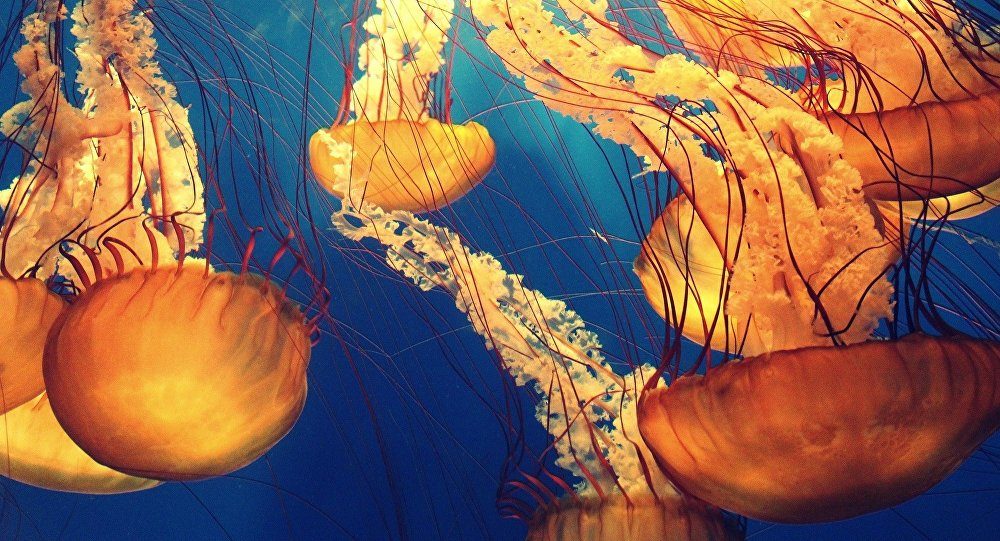
© CC0 / Pexels
Translucent jellyfish, colorful corals and waving sea anemones have very different bodies but all fall on the same big branch in the animal family tree.
Jellyfish actually start out anchored to the sea floor, just like corals and anemones. Researchers at the Okinawa Institute of Science and Technology Graduate University (OIST) recently uncovered which genes allow jellyfish to graduate from this stationary stage and swim off into the sea.
Early in their life cycles, jellyfish develop from larvae into polyps -- immobile, stalk-like structures rooted into the sediment. Anemones and coral live out their lives in this state, which earned them the name anthozoa or "flower animals" in Greek. Jellyfish set themselves apart from anthozoans by being able to develop from the polyp stage to the medusa stage, blossoming into the luminous, bell-like creatures we know and love.
The new study, published in April 16, 2019 in
Nature Ecology & Evolution, reports the genomes of two jellyfish species and investigated why some creatures can enter the medusa stage while others remain frozen as polyps. The genomes can be browsed online and compared to other species on the OIST BLAST server.
Newly Decoded Jellyfish GenomesOIST researchers and colleagues from Japan and Germany compared the genomes of a moon jellyfish (Aurelia aurita) and a giant box jellyfish (Morbakka virulenta). In Japanese, these species are known as the "water jellyfish" and "fire jellyfish," respectively. The fire jellyfish is highly venomous and owes its name to its painful, burning sting.
"By comparing two different types of jellyfish we expected to identify some universal rules on how to make a medusa stage," said Dr. Konstantin Khalturin, first author of the study and a scientist in the OIST Marine Genomics Unit led by Prof. Noriyuki Satoh.
As a jellyfish exits its polyp stage and leaves the sandy sea floor, different genes switch on to drive its development. To identify these special genes, the researchers first had to catalogue all the genes present in their sample jellyfish species.
"We then looked at how these genes behaved in the polyp and jellyfish stages of their lifecycles," Khalturin said.
The researchers sequenced the complete genome of a moon jellyfish from the Baltic Sea and giant box jellyfish from Japan. Genomes contain all the instructions to build and maintain an organism, encoded in individual building blocks known as genes. Along with a creature's genetic composition, the order in which these building blocks are lain helps determine how a creature develops. The researchers compared their freshly decoded jellyfish genomes to those from corals and anemones, pinpointing which genes appeared in each animal and in what sequence.
"We expected that the genome organization in the two jellyfish would be more similar to each other than to the genomes of sea anemones or corals," said Khalturin. Surprisingly, the gene order in the moon jelly genome resembled anthozoans much more closely than fire jellyfish. In contrast, the genetic composition of the two jellyfish hardly overlapped; their genomes differ as drastically as humans do from sea urchins.
What Makes the DifferenceThe results suggest that the giant box jellyfish genome must have been vigorously reshuffled at some point in its evolution. The dearth of similarities between moon and giant box jellies convinced the researchers that there is no universal region within jellyfish genomes responsible for orchestrating the medusa stage formation.
One question remained: why can't corals and anemones enter the jellyfish stage?
To solve this mystery, the researchers assessed which genes were active in the polyp and medusa stages of both jellyfish. They compared these distinct patterns of gene expression to those observed in 11 different cnidarian species -- the taxonomic group that encompasses medusozoans and anthozoans. Remarkably, they found that
coral and anemones contain about two-thirds of the genes active in the moon jellyfish's medusa stage.But moon jellyfish have a special genetic toolkit: an elite arsenal of genes that activate during their medusa stage but are absent in anthozoans.
Devoid of a jellyfish stage, corals and anemones lack the genes to grow certain organs and tissues, such as eyes and specialized swimming muscles. The researchers found that water and fire jellyfish share about 100 of these species-specific genes that only switch on in their jellyfish stages. A large proportion of these genes code for transcription factors, proteins that fine tune which genes are expressed, when and in what quantities.
Looking forward, the researchers plan to sequence the genome of a local box jellyfish called the Okinawan sea wasp (Chironex yamaguchii, "habu-kurage"), which will provide a closer comparison to the fire jellyfish. Future studies could advance our understanding of how jellyfish evolve and what sets them apart from their blobby brethren and other creatures of the deep.
Reader Comments